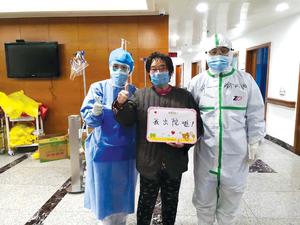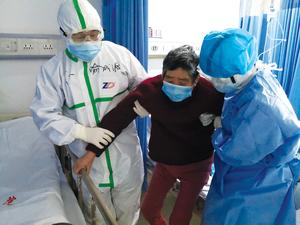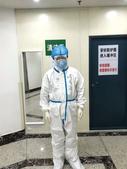Most patients who come down with the novel coronavirus do recover but, for some, they have to endure scars that’ll never heal. Wang Yuke reports.
 Yu Chengbo (right), a frontline doctor in Wuhan, sends off a COVID-19 patient who recovered and was discharged. (PHOTO PROVIDED TO CHINA DAILY)
Yu Chengbo (right), a frontline doctor in Wuhan, sends off a COVID-19 patient who recovered and was discharged. (PHOTO PROVIDED TO CHINA DAILY)
When Sun Jihong, 69, caught the COVID-19 virus, her world turned upside down — she was certain she would die.
But, after 16 soul-destroying days of intensive treatment at a hospital in Wuhan, she survived. She still can’t really believe it all, including the reality that she walked out of the hospital ward, healed.
The bug hit hard and fast — coughing, moderate diarrhea, reduced and yellowish urine. She felt weak. She called her daughter, a physician. “She rushed home and took me to hospital for a chest X-ray,” says Sun. The lung imaging confirmed she had the coronavirus.
It was excruciating to see the displays of apathy and indifference among patients toward the doctors ... when we approached them (patients), they ran away and hid
Yu Chengbo, frontline doctor in Wuhan
Beds in nearly every nearby hospital were bursting at the seams. Hundreds of people had the virus. Luckily, for Sun, her daughter helped her find one.
“I was immediately put into intensive care, quite unconscious.”
She woke up the next day — a little better than the day before. Heavy doses of intravenous followed. “I lay on the bed, alone. My breathing was labored and I was too feeble to move. I was attached to several cold, life-support machines, with a dozen drip bottles hanging above me. I stared at the white ceiling and could feel tears rolling down my cheeks.”
Sun confessed to shedding endless tears on her sickbed. Word spread that many people were dying of the disease. She fell into despair. “I never thought I could make it. It was debilitating and intimidating,” she sobbed. She rolled up her sleeve, revealing an unhealed bruise resulting from the injections. “I made end-of-life wishes. I even told my daughter where my jewelry was kept, and gave her the lock codes to my safe boxes.”
Every time Sun talked about death, her daughter told her to stop and wouldn’t let her mother even think about death.
“I lost count of how many times I had wept. I thought a lot. I thought about my beloved grandson, who grew up with me. He likes ‘grandma food’. His favorite dish is sauteed beef or lamb with vegetables that I often cooked for him. Once, he invited his friends over, I treated them with barbecue. They liked it so much … He won’t be able to eat my food anymore,” says Sun, fighting back tears.
“I thought about my ill husband. He has been paralyzed on his right side for over 21 years. He had a cerebral hemorrhage. He depends on me. And I was leaving him … I shouldn’t have been impatient with him sometimes, snapped at him and complained so much…”
Life-threatening illnesses like COVID-19 are not anything like stresses we brush off every day, says Ivan Mak Wing-chit, chairman of the Public Awareness Committee at the Hong Kong College of Psychiatrists. “It’s a trauma. Ordinary life stresses can be handled easily. It won’t be like that for people with COVID-19, he says. Mak, who has been following up on SARS survivors, says some patients never fully recover from such a disease because it leaves heavy emotional scars, capable of wielding physical damage.
 Dr Yu Chengbo (left) says he has witnessed the agony and psychological wounds COVID-19 patients have gone through. (PHOTO PROVIDED TO CHINA DAILY)
Dr Yu Chengbo (left) says he has witnessed the agony and psychological wounds COVID-19 patients have gone through. (PHOTO PROVIDED TO CHINA DAILY)
Emotionally struggling
Patients have some initial mental disturbance after a sudden, traumatic emergency. That’s “acute stress reaction”. It’s like post-traumatic stress. The symptoms are very much alike. The difference is that the acute stress normally hangs on for the first couple of weeks. Post-traumatic stress can last for years or even for the rest of a person’s life. Acute stress comes in the first month after a trauma, followed by intense fear and emotional distress. The illness itself is the primary trigger but there can be others. Factors in the environment can make things worse. Compulsory quarantine and isolation, absence of social support, when the patient needs treatment in seclusion, are a few examples. Another could be deficient medical care, such as, in the present situation, patients realizing their doctors have very limited resources to help because the disease is new to them too, and doctors have to make the “best guesses” for treatment.
Personality too plays a part. Some individuals are chronically prone to anxiety and have greater acute stress reaction than others, says May Lam, a psychiatry specialist in Hong Kong. The vulnerable group often shares a “high trait anxiety” personality, which means they tend to report fears, worries, and other anxieties across situations in life when most people would barely react.
However, anxiety starts to twist their thinking. They’re likely to fixate on negative thoughts, looking for the worst. Technically, these are known as “catastrophic thoughts”, says Mak. Because they lean toward the negative, they tend to amplify their fears or dwell on the sources of their stress. Their mood worsens, so does the intensity of catastrophic thoughts. It creates a vicious cycle.
Finally, stress can overwhelm a person. But how? Mak uses an analogy to explain. “There’s a scale balance in us. On the negative side are insecurity and even the threat of loss of life. On the positive side is the person’s ability to cope and benefit from the support of others.” If a stress victim feels the support is inadequate, whether from family members who’re unable to see or talk to them, or from doctors who aren’t certain of how to treat the patient, the balance is tipped toward the negative. Then, stress really takes hold.
 Sun Jihong, 69, experiences deep fear, grievance and solitude in hospital. (PHOTO PROVIDED TO CHINA DAILY)
Sun Jihong, 69, experiences deep fear, grievance and solitude in hospital. (PHOTO PROVIDED TO CHINA DAILY)
Despite Sun’s melancholy and resignation to defeat, she reacted well to treatment. She thinks it’s because of her sound health before she got sick. On Feb 21, her nucleic acid tests turned out negative. The infection was gone and she was discharged from hospital. She had to stay isolated for another 14 days before going home and so the authorities took her to a designated hotel for another period of solitary life.
March 5 was the big day. She went home. The period preceding that moment had been emotional roller-coaster ride. There was a final nucleic acid test to ensure the virus was well and truly gone. “I had been waiting for the result for a good part of the day. I fidgeted around my room. I started betting that the result must be positive … Oh My … I thought if I’m sent back to the hospital, it will be my death sentence. I cried my eyes out,” wept Sun as if she was transported to that stressful day. “At around 3:30 pm, the result came out. My heart settled, heaving a long sigh of relief. I felt so good…”
She counts herself the winner of the hardest fight in her life. “I thank my daughter for hauling me back from death’s grip. I gave her life 43 years ago, and today she saved my life,” says Sun, grateful, for a new lease on life.
After her brush with death, she now cherishes life more than ever. “I’ll take good care of my husband, my life’s companion. He hasn’t had a good bath since I was hospitalized.”
Some people do get back to normal after the initial stress. Some don’t. They may have flashbacks and a wide malaise of general numbness. They try to shut out thoughts of the trauma, withdrawing from others, even to the point where they no longer make eye contact with others.
Mak talked about one of his patients who recovered from SARS, but remains emotionally scarred. During the outbreak, she and her spouse were infected. Her husband was seriously ill and transferred to intensive care unconscious. Her condition was mild. Both survived. Years later, the wife started experiencing flashbacks. “Flashbacks are different from ordinary memories,” notes Mak. With normal memories we just recall what happened and acknowledge it was all in the past. People with flashbacks believe they’re right there, going through the most frightening experiences in their lives — in real time. The more the woman tried to force the dreadful memories from her mind, the more intense they became. The woman had bouts of shortness of breath. Flashbacks can lead to psychical harm, Mak warns, including muscle tension, breathing difficulties, headaches, chest pains and gastrointestinal discomforts.
 Yu Chengbo, frontline doctor in Wuhan. (PHOTO PROVIDED TO CHINA DAILY)
Yu Chengbo, frontline doctor in Wuhan. (PHOTO PROVIDED TO CHINA DAILY)
Scars imprinted
Yu Chengbo led the first group of medical responders from Zhejiang province into one of Wuhan’s worst-hit districts. They got there on the first day of the Spring Festival and started working right away. Yu is head physician at the First Affiliated Hospital, College of Medicine of Zhejiang University.
Yu and his team worked on the frontline, day and night. He was taken aback by the mental state of the patients, their hysteria and open hostility. He was stunned and injured. There was one man, in his 40’s, Yu recounted. The man’s symptoms were mild, but he was distressed over his elderly parents. He was their support, their breadwinner. His sense of helplessness plagued as he lay sick. Yu spoke about the man’s getting down on his knees begging the doctors to save him. He was inconsolable. “He could barely stay in the ward. He demanded we let him go.
“We couldn’t, of course. The gates were locked and guarded, which made him feel like a prisoner.” His condition deteriorated fast. The next day, he slipped into a coma and was dead on the fifth day.
“The disease didn’t kill him,” says Yu. The man was middle-aged and apart from the infection, healthy. He should have pulled through. “It was his emotional state that killed him.”
When people are confronted by a traumatic event, if the cause is something invisible or intangible, they incline to direct their fears and hostilities to something tangible. It’s a way of coping. In the case Yu cites, the patient could not find an outlet for his fears. Like many other patients, the man came to view doctors almost as if they were connected to his affliction.
For some patients, the sight of doctors can remind them they are sick, says Samuel Ho, professor of psychology at the City University of Hong Kong. Doctors become the embodiment of the disease, and the patients’ natural response is “flight”.
It was excruciating to see the displays of “apathy and indifference” among patients toward the doctors, Yu laments. He believes he can identify the visceral “distrust” of doctors among the patients, from a distinctive smell he learned to recognize. He noticed it in the first couple of days. He remembers that, “when we approached them (patients), they ran away and hid”.
It is a natural response to potential harm, threat or danger — an evolutionary way of coping with an emergency. This is the well-known theory of “flight or fight” first described by Walter Cannon in 1920s. “When one is in trouble, he could be extremely anxious to the point that he avoids everybody,” explains Mak.
The release of stress hormones from our adrenaline glands, followed by physiological changes, notably increasing the heart rate and blood pressure, is a critical part of natural self-defense, notes Lam. That helps us to better prepare for the imminent threat and danger. But if the stress hormone is released in excess, especially in the case of COVID-19, where there’s too much unpredictability and uncertainty to be mentally prepared, the stress and anxiety can be unbearable. “The excessive anxiety, eventually, will affect our immune system, doing us no good to fight the illness,” she says.
Amid the slew of psychological issues that COVID-19 patients experience, Mak reckons it may be too much for frontline staff to juggle between treatment of the illness and mental health service. Lam encourages online psychological counseling in situations like COVID-19.
“Bringing their family members in, for example, allowing them to have video calls sometimes or bringing them up to date on their families’ matters, could be the best antidote for their emotional trauma,” says Mak.
All in all, we can’t disregard the mental scars left for COVID-19 patients. The disease will be under control, but many, really, may never recover as the mental and emotional scars bring them pain.
Contact the writer at jenny@chinadailyhk.com


